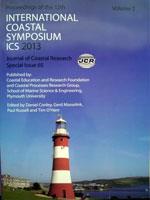White, J.L., 2013. Measuring clast transport signatures at a barrier terminus.
At a macrotidal prograding and transgressive, mixed sand and gravel barrier, continuous gravel transport logging provides insights into the relationships between the incident hydrodynamics and the morphodynamics. Two piezoelectric gravel transport sensors (GTS) were aligned in either the cross-shore or the alongshore directions over two low and two moderate energy equinox spring tide events. GTS measure gravel transport as an electronic pulse, where the frequency and amplitude measures clast transport rate and presumably number coincident with the passage of a wave, or per event. Clast transport occurs in bursts characterised by greater than average amplitude peaks, thought to coincide with wave phenomena. Further, these bursts do not appear to progress in a linear relationship with the wave parameters. For example, series of burst can be greater before, or after high tide, and are often polymodal, and low wave energy transport rates can be greater than moderate transport rates. The cross-shore configuration measured the clast transport over a gravel substrate at a high water ridge, and the adjacent landward high tide swash zone. As expected transport frequencies were greater over the high water ridge than at the adjacent swash zone. However, the clast transport per wave can be greater at the swash than at the high water ridge, suggesting the importance of the prolonged breaking wave inducing clast transport. The average number of clasts transporting per event can be greater at the high water ridge than at the swash. Also, sediment volume changes were greater on the high water ridge, marked by small depositions, where as the swash zone could be depositional, or erosional. The longshore configuration measured the simultaneous clast transport over gravel or sand substrates. The transport frequencies were greater over the gravel than the sand substrate. Greater volumes of sediment were transported to landward over the sand than the gravel substrates. The clasts transporting over the sand substrate per wave can be greater than clasts transporting over the gravel substrate, suggesting the importance of sand transport and accumulation as a process associated with prograding gravel barriers. However, the average number of clasts transporting per event over the gravel were generally greater than over the sand substrates, hence gravel substrate clasts can transport but with little net transport direction. The deployment of GTS enables indications of gravel transport characteristics continuously within an active barrier system environment.





